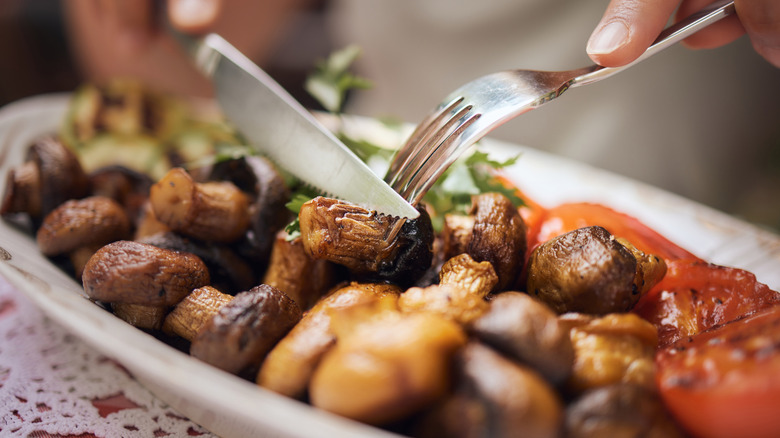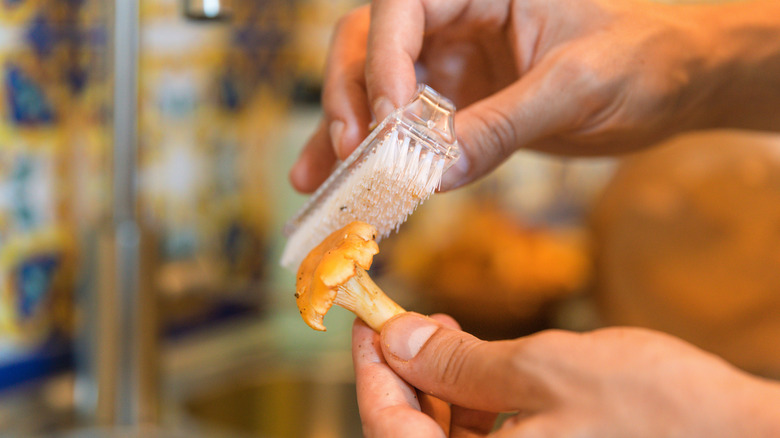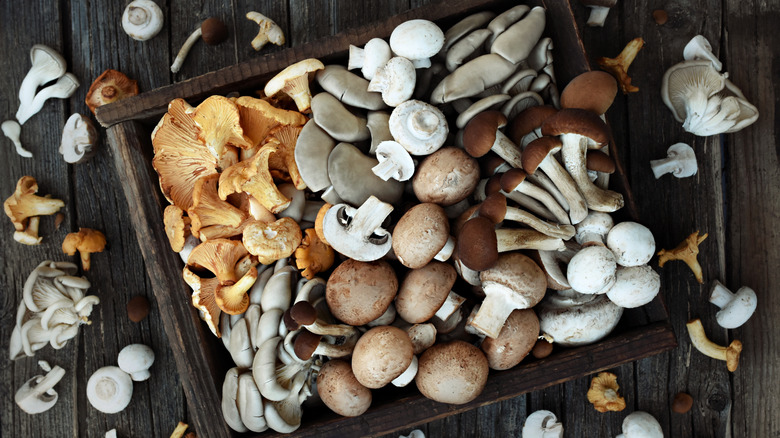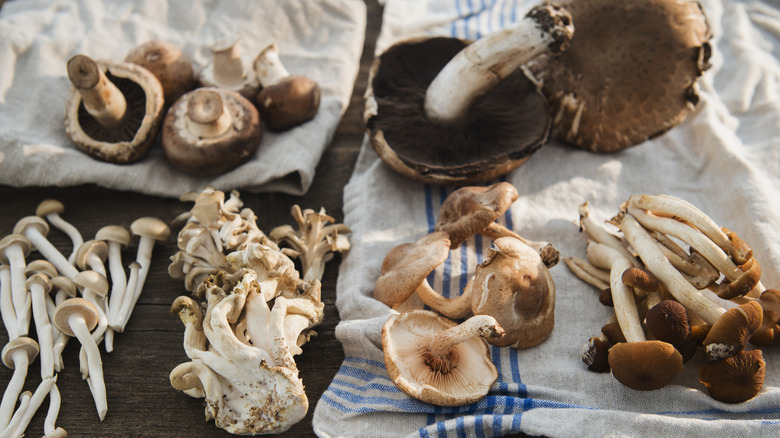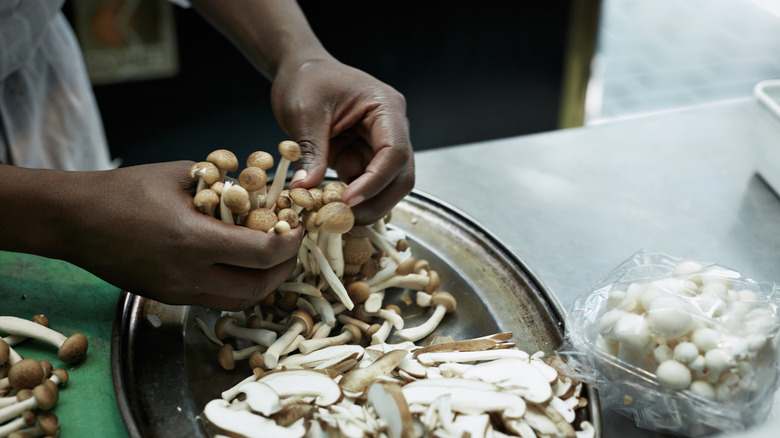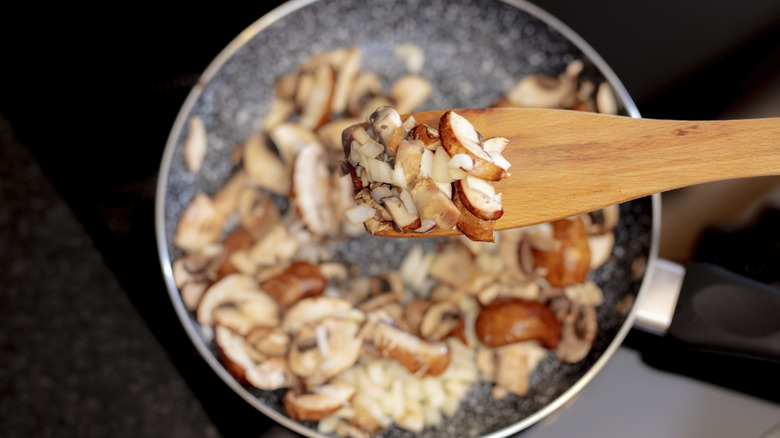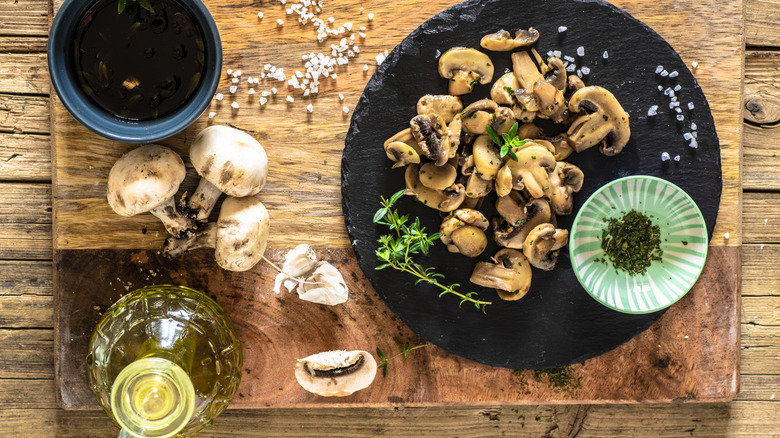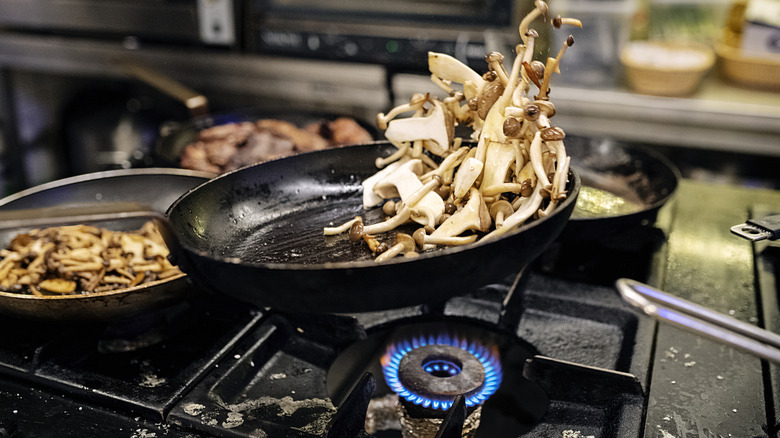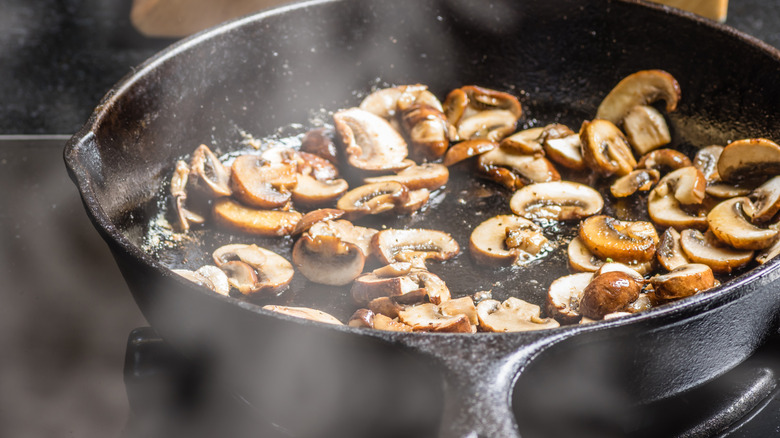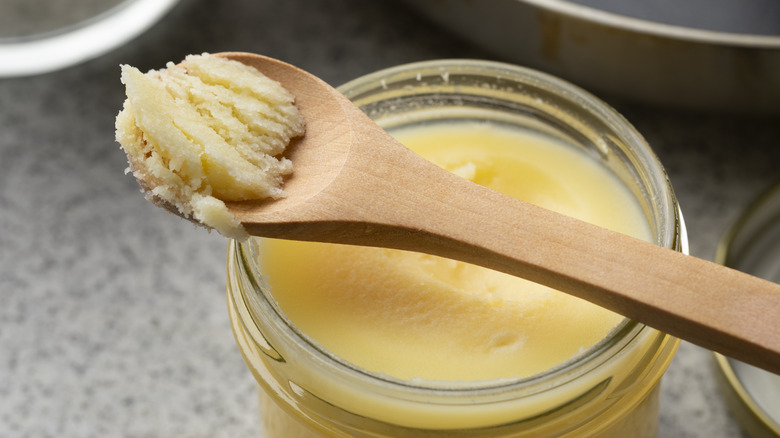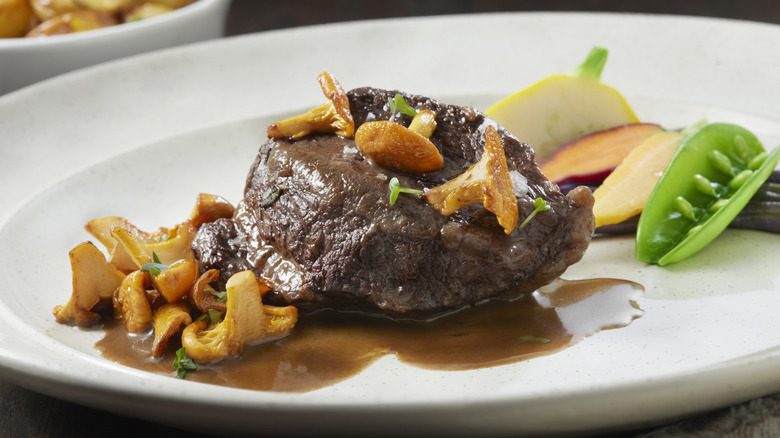Restaurant Mushrooms Taste So Delicious: These Chefs Explain Why
One of the best things about the food world is that there's always something new to learn. No matter how many of Matty Matheson's incredibly practical tricks you've picked up from watching his reliably hilarious videos, there's always something else just waiting to be discovered. Take Jacques Pépin's love of mushrooms: Pépin never lets a mushroom go to waste. It always seems to add that extra je ne sais quoi.
That's fascinating, especially with such a polarizing ingredient. Ask anyone how they really feel about mushrooms, and you're likely to get enthusiastic answers whether someone loves them or hates them. Even if you're not cooking — or eating — them at home, you'll order a restaurant dish that has them and happily enjoy the delicious depth of earthy flavors they bring. They're just better when they're from a restaurant, aren't they? Ever wonder why?
We did, so we reached out to the professionals to find out just what restaurants do to make their mushroom dishes so good. We spoke with Masterchef India judge and Executive Chef of Kashkan Ranveer Brar; Executive Chef and Culinary Advisor at Restaurantji Kevin Ashton; Executive Chef at the University of Santa Cruz and founder of Simply Cooking Recipes Ryan Yates; Alex Carballo, the Culinary Director of Fox Point Farms; and Chef Fanila N. Roshan, the owner of Mimi's Kabob. They gave us a behind-the-scenes look at what makes restaurant mushrooms so much better, and also shared some invaluable hints that you can use in your own kitchen.
Restaurant chefs keep their mushrooms dry
Ryan Yates is the executive chef at the University of California and the founder of Simply Cooking Recipes. He told us that one of the most important steps that restaurants take is proper prep, and that starts with cleaning. Do a quick internet search, and you'll find a lot of opinions on the right way to clean mushrooms and whether or not you should wash them. The professionals say that are a few reasons why it's generally not a good idea. Mushrooms already have a high water content, which means turning them from spongey to crispy is already an uphill battle. Washing is only going to add more water, and they're not like, say, an apple — you're not going to be able to easily dry mushrooms.
Yates says that the pros know this and work around it. "In restaurants, we take extra care to keep mushrooms dry," he tells us. "We use a soft brush or damp cloth to gently wipe off any dirt. This lets them caramelize and sear properly when cooking — not steam — developing that deep, umami flavor."
Kevin Ashton has more than four decades of experience working in restaurants, including at Bermuda's The Armoury and the Grand Hotel Krasnapolsky in Amsterdam. He agrees that dry mushrooms are key to creating the perfect texture, explaining, "Excess moisture can cause them to steam rather than brown, making them soggy instead of crispy."
In a restaurant, they know how to prep different varieties
We get it: Life is busy, and sometimes, you've got to skip some steps to get dinner on the table. But, there's the thing — properly preparing mushrooms for cooking is incredibly important, and that's reflected in the final dish. Different types of mushrooms can also require different prep methods, and professional chefs know all the ins and outs.
Let's take portobellos. According to Alex Carballo, culinary director of Fox Point Farms, professionals prep these fan favorite mushrooms by removing the stems and the gills underneath the cap. That will help reduce the mushroom's moisture content, but he also stresses, "Properly cleaning mushrooms often depends on where they came from and whether the farm they originated from has already processed them ... Keep in mind that some varieties require more prep than others."
Ryan Yates agrees, saying that there is often extra work that goes into prepping restaurant mushrooms, and restaurants aren't only taking these extra steps for appearances. Trimming the stems from mushrooms helps chefs make sure everything cooks evenly. In some cases, there's another reason to remove certain sections of certain mushrooms. "The tough parts, especially on shiitakes, can turn bitter and affect the final taste," Yates says. That's a valuable knowledge base that restaurant chefs can tap into to make sure that they're not sabotaging a dish from the start.
Restaurants use multiple kinds of mushrooms in the same dish
Button mushrooms are some of the most commonly seen mushrooms at grocery stores, and there's a chance that you might pick up a container and use those in your dishes. That's fine, but when it comes to restaurant dishes, chefs often combine different types of mushrooms to create something stellar.
"In restaurants, we love mixing different mushrooms because they bring different flavors and textures," says Ryan Yates. "At home, I'd recommend blending shiitake, cremini, and oyster mushrooms. Shiitakes have that rich, umami flavor, oysters are delicate, and creminis are great for texture." Restaurants also know exactly how to stagger each mushroom to guarantee each different variety has enough — but not too much — cooking time, which is crucial for bringing everything together at the end.
Have you seen those mushrooms at your go-to grocery store? Perhaps, perhaps not — and here's another advantage restaurants have. Alex Carballo adds that depending on the restaurant and availability in your area, "Restaurants do have access to greater varieties of hard-to-get mushrooms. Think truffles, porcini mushrooms, and morels, for example." That allows them to make dishes you just can't replicate. If you want to try to find some of these mushrooms, you might have to do some searching: Check local farmer's markets, and you may also find must-buy varieties of mushrooms at Asian grocery stores.
Restaurants can often source higher-quality, fresher mushrooms
It makes sense that a dish made with high-quality, fresh ingredients is going to be better, and that's part of what gives restaurants an upper hand in some things — especially produce. Alex Carballo says that although store-bought mushrooms are fine, "Chefs often have access to a wider variety of fresh options." That's especially true when it comes to some of the rarer varieties. As restaurants can go through regular suppliers, it just makes things easier — especially in certain areas.
Mushrooms are in season year-around, are continuously harvested, and those harvests are labor-intensive. They have to be picked by hand, and depending on where you are, you might have amazing access to fresh mushrooms. Why? In 2012, southeastern Pennsylvania was the source of around half the country's mushroom crop, and today, that's grown to about two-thirds.
If you don't Live next to this magical mushroom paradise, Ryan Yates says there are a few things you can do to try to make your own restaurant-quality mushroom dishes. He suggests buying loose mushrooms to make sure you're not getting any that are past their prime and checking specialty stores and farmer's markets for the freshest options. "By focusing on freshness and quality, you can get as close as possible to the restaurant-level ingredients chefs use," he says.
Restaurant chefs are professionals when it comes to when and how to season
Knowing when and how to season a dish makes a huge difference, and there's no one rule for every application. The professionals working in the restaurants?Let's take steak. You've heard about when you should season a steak — before grilling — right? That's obviously at the beginning of the cooking process, and if you try to apply that same rule to mushrooms, that's one reason your dishes aren't coming out with a restaurant quality.
Kevin Ashton has the seasoning rule that all good restaurant chefs know: "Salt draws out moisture from mushrooms ... If added too early, it can prevent them from browning," he says. "Season toward the end of the cooking process for better results."
There's also an art form to seasoning mushrooms in a way that adds and enhances flavor without turning them too salty. When a chef works in a restaurant, they're making the same dishes so many times that it's easier to perfect them. Consistency is key in a restaurant, after all, so they know how quickly salt can ruin mushrooms. Fox Point Farms' Alex Carballo says that the pros knew to err on the side of caution. "With mushrooms naturally offering a distinct flavor profile, simply adding a pinch of salt can enhance taste without being too overpowering."
The professionals know how to pair different mushrooms with different herbs and aromatics
In order to truly bring out all the delicious, umami flavors that come with mushrooms, a lot that goes into a dish that gets hidden behind the scenes. According to Masterchef India judge and head of Kashkan Restaurants Chef Ranveer Brar, restaurant dishes use things like garlic, onions, and fresh herbs to the fullest potential. "Restaurants' stir-fried or grilled mushrooms are likely to be flavored with garlic, spring onion, and rosemary or thyme for a deeper, garlicky taste," he says. "It is easy to enhance the taste of mushrooms by using fresh herbs and truffle oil, which make mushrooms — an ordinary dish — feel exceptional."
Mimi's Kabob Chef and Owner Fanila M. Roshan agrees, saying that restaurant dishes are carefully crafted to "build layers of flavor." She says that flavors are often added via aromatics, by deglazing with a liquid, or topping the cooked dish with herbs and spices. While home cooks can experiment with building their own flavor profiles, looking at recipes like our caramelized mushroom pasta will help give an idea of how ingredients like white miso, sage, and thyme can work with garlic and onions to create a restaurant-worthy dish.
The professionals know that high heat and controlled cooking is key
Ask anyone who hates mushrooms what they don't like, and it probably has to do with the texture. That funky, weird texture can develop when mushrooms end up simmering instead of searing, and here's where the commercial equipment that the pros use becomes incredibly important.
Roshan explains, "Restaurants often have access to professional-grade equipment, such as induction cooktops or high-heat ovens, which allow for more controlled and efficient cooking." That high heat is key, allowing for sauteeing and searing mushrooms to caramelize and enhance flavors and textures.
Alex Carballo also speaks to how important high heat is in creating stellar mushroom dishes. He says that restaurants have an advantage that starts with equipment: "With commercial kitchen equipment working with higher BTUs (British Thermal Units) than most home appliances, professional chefs can sear mushrooms at a much higher temperature. This allows for a beautiful Maillard reaction that enhances flavor and richness."
They're great at managing what's going on in the pan
Watch a professional chef at work, and you'll quickly become convinced that, yes, there is such a thing as magic. For a trained chef, a skillet can be an extension of their arm. When it comes to mushrooms, though, there's a little more to it than just knowing how to flip food.
For starters, Roshan says that the professionals know just how much to fill the pan to get the result they're looking for: Overcrowding mushrooms is a massive mistake. Less is better, and that's a major part of how restaurants get that amazing texture. "Not overcrowding the pan [allows] mushrooms to caramelize rather than steam," she says.
Brar and Ashton also say that deglazing the pan after sauteing mushrooms is key. Brar says that restaurant chefs have an arsenal of ingredients that they use for deglazing the pan and adding another layer of flavor to any mushroom dish, including sherry and wine. "The mushroom's natural taste is enhanced by the alcohol [that's] added after the thickening of the sauce," he says. Ashton adds, "This boosts umami and gives the mushrooms a restaurant-quality depth." He also says that deglazing releases any deliciously caramelized bits that might be stuck to the pan, which then make it into the dish to add still more flavorful textures.
Restaurant dishes make the most of fats
Knowing how much butter to use can be a tough thing to judge when you're sauteeing, but this is another thing that restaurant chefs have down to a science. Brar says, "Restaurant kitchens make a more liberal use of both butter and fats," and that improves on flavor and texture. It's something that you can experiment with at home, especially in a dish like The Takeout's own soy-wasabi butter mushrooms dish. That uses butter to create both a delicious sauce and texture.
But, according to Yates, restaurant chefs have a few more tricks that go beyond butter. "Restaurants often go a step further by using clarified butter," he says. Why is clarified butter so tasty? It's basically butter without the water and milk solids. This isn't only delicious — there's a practical reason that restaurants opt for using this type of butter over what you might have in your fridge at home. "It has a higher smoke point, which means it's perfect for high-heat cooking without burning," Yates says. In addition, he says that restaurants often use olive oil, duck fat, or even bacon fat in mushroom dishes for even more savory flavor. The good news? Those ingredients are widely available and home cooks should definitely give them a try.
Plating and presentation are a huge deal
Be honest: When you're serving dinner, are you concerned with how aesthetically pleasing a dish looks, or are you just trying to get the family wrangled, seated, and eating? One of the reasons that mushrooms taste better in a restaurant is because professional chefs pay much more attention to presentation. Fanila N. Roshan explains, "How we present mushrooms plays a crucial role in their appeal. A beautifully plated dish can elevate the dining experience ... showcas[ing] the vibrant colors and textures of mushrooms."
Interestingly, there's some scientific evidence to back up the fact that we think food tastes better when it looks better. A 2013 study done by the Montclair State University's Department of Psychology and the Culinary Institute of America found that when diners were served artfully arranged plates and less carefully crafted meals, they found that the carefully presented meals tasted better (via ScienceDirect). While there are practical reasons for proper plating — like preventing some parts of the meal from becoming soggy, for instance — it's also an art form. The professionals know how to do it right, and the first bite really is with the eye.
